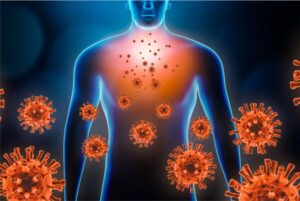Here’s what we know so far about COVID-19 transmission.
When are people most contagious?
According to the latest evidence, people most commonly spread the virus to each other 2-3 days before symptoms start. Most people seem to be most contagious 1-2 days before they become sick. Scientists think that the “viral burden” — how much virus you have replicating inside your body with the ability to spread to others — is linked to the severity of your symptoms.
But this is still being worked out because some people never develop symptoms but are still contagious at some point during their infection.
Once someone is infected, it can be 5-6 days before symptoms start, though some people may not start feeling sick until 14 days after they were exposed (and some don’t end up feeling sick at all).
What’s the most common way that the virus spreads?
Transmission through infected droplets appears to be the most common way that the virus spreads. Respiratory droplets are usually heavy droplets that are released when someone coughs or sneezes. This is where the “6-feet rule” comes from, because these droplets generally fall out of the air within 6 feet.
More and more research, however, is pointing to droplets as a continuum — with smaller droplets, called aerosols, released just by talking or breathing. The louder you talk or sing, the farther they may float. Because aerosols are much smaller, they can stay suspended in the air for a longer period of time and travel farther. So 6 feet in a poorly ventilated space may not be enough distance to protect you.
An interesting “real-life experiment” was recently published showing what happened to travelers on two buses carrying passengers to a ceremony in China. One bus carried an infected person, while another had no infected people. This was early in the pandemic, so no one was wearing a mask. Over 1/3 of the people on the bus with the infected person caught the virus, while no one on the other bus caught it. It didn’t matter how far people were sitting. Even people sitting very far away from the infected person caught the virus.




